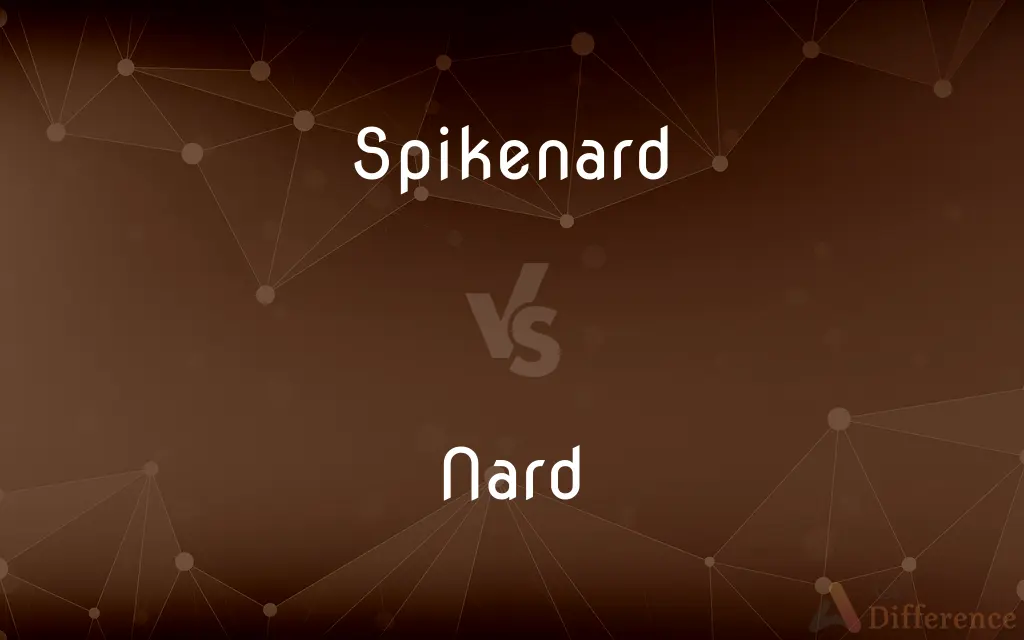Spikenard vs. Nard — What's the Difference?
By Tayyaba Rehman & Fiza Rafique — Updated on March 28, 2024
Spikenard is a specific herb known for its aromatic rhizome, used in ancient perfumery and medicine, while nard refers generally to the same plant or its oil, often highlighting its historical or biblical context.

Difference Between Spikenard and Nard
Table of Contents
ADVERTISEMENT
Key Differences
Spikenard, scientifically known as Nardostachys jatamansi, is a flowering plant valued for its fragrant rhizome, used historically in perfumery and medicinal applications. On the other hand, nard is a term that often refers to the same plant or specifically its oil, and is frequently associated with its use in ancient texts and religious rituals.
Spikenard oil, derived from the spikenard plant, is notable for its intense aroma and has been used since ancient times for anointing in religious ceremonies. Whereas nard, while referring to the same essential oil, is often highlighted in biblical scriptures and ancient texts, emphasizing its value and sacredness across different cultures.
The cultivation and harvest of spikenard require specific environmental conditions found in the Himalayan mountains, making it a rare and valuable commodity. In contrast, nard, as a term used to describe the same plant or its product, emphasizes the historical and cultural significance rather than the botanical aspects.
In traditional medicine, spikenard is used for its therapeutic properties, such as sedative and calming effects, indicating its importance in herbal medicine. Nard, on the other hand, while also recognized for these properties, is more often celebrated for its historical and spiritual significance.
Despite the overlap in what they refer to, the context in which spikenard and nard are used can differ. Spikenard is typically mentioned in discussions focusing on botany, herbal medicine, and perfumery. Nard, however, is more likely to be referenced in religious, historical, or literary contexts, reflecting its deep cultural resonance.
ADVERTISEMENT
Comparison Chart
Definition
A flowering plant known for its aromatic rhizome.
Often used interchangeably with spikenard, particularly referring to its oil.
Use
Perfumery, medicinal applications.
Anointing oil, religious ceremonies.
Origin
Himalayan mountains.
Term with historical and biblical associations.
Cultural Significance
Valued in herbal medicine and ancient perfumery.
Emphasized in religious texts and ancient history.
Context
Botanical, herbal medicine, perfumery.
Religious, historical, literary.
Compare with Definitions
Spikenard
Celebrated for its use in ancient perfumery and religious ceremonies.
Spikenard oil was found in alabaster jars in ancient Egyptian tombs.
Nard
Seen as a luxurious and sacred oil in ancient cultures.
Nard was considered a luxury in Roman times, often used in royal anointments.
Spikenard
Grows primarily in the high altitudes of the Himalayas.
They trekked in the Himalayas to study the natural habitat of spikenard.
Nard
More commonly associated with its historical and spiritual significance.
In scripture, nard is mentioned as a precious substance, indicating its value.
Spikenard
The oil is extracted from the rhizome of the plant.
Spikenard oil is extracted through steam distillation, capturing its unique scent.
Nard
Holds a significant place in biblical and historical texts.
The ancient text described nard as a symbol of love and devotion.
Spikenard
Used in traditional medicine and as a fragrance in perfumery.
The herbalist incorporated spikenard into her remedies for its calming properties.
Nard
Involves the same process as spikenard, emphasizing the oil's sacred use.
The nard oil, extracted for religious ceremonies, was highly valued.
Spikenard
Spikenard, also called nard, nardin, and muskroot, is a class of aromatic amber-colored essential oil derived from Nardostachys jatamansi, a flowering plant in the honeysuckle family which grows in the Himalayas of Nepal, China, and India. The oil has been used over centuries as a perfume, a traditional medicine, or in religious ceremonies across a wide territory from India to Europe.
Nard
Refers to the same plant as spikenard, highlighting its oil used in ancient and religious contexts.
Nard oil was used by Mary to anoint Jesus' feet, according to the Bible.
Spikenard
An aromatic perennial herb (Nardostachys grandiflora) of the Himalaya Mountains, having rose-purple flowers. Also called nard.
Nard
See spikenard.
Spikenard
An ointment of antiquity, probably prepared from this plant.
Nard
Nardostachys jatamansi, a flowering plant of the valerian family that grows in the Himalayas, used as a perfume, an incense, a sedative, and an herbal medicine.
Spikenard
Any of several plants of the genus Aralia, especially the North American species A. racemosa, having small greenish flowers, aromatic roots, and bipinnately compound leaves.
Nard
A fragrant oil from the plant, formerly much prized.
Spikenard
A perfumed ointment, extracted from the plant Nardostachys jatamansi that belongs to the Valerian family and grows in the Himalayas.
Nard
(Aralia racemosa), a North American perennial herb with an aromatic root.
Spikenard
The plant Nardostachys jatamansi (syn. Nardostachys grandiflora).
Nard
A testicle.
The soccer ball hit me right in the nards!
Spikenard
Lavandula stoechas, another species used in antiquity to produce an aromatic oil.
Nard
An East Indian plant (Nardostachys Jatamansi) of the Valerian family, used from remote ages in Oriental perfumery.
Spikenard
Any plant of the genus Aralia of the Araliaceae family.
Nard
An ointment prepared partly from this plant. See Spikenard.
Spikenard
(Maianthemum racemosum, syn. Smilacina racemosa)
Nard
A kind of grass (Nardus stricta) of little value, found in Europe and Asia.
Spikenard
Ploughman's spikenard (Inula conyza, now Pentanema conyzae).
Nard
An aromatic ointment used in antiquity
Spikenard
(Asarum europaeum).
Spikenard
An aromatic plant. In the United States it is the Aralia racemosa, often called spignet, and used as a medicine. The spikenard of the ancients is the Nardostachys Jatamansi, a native of the Himalayan region. From its blackish roots a perfume for the hair is still prepared in India.
Spikenard
A fragrant essential oil, as that from the Nardostachys Jatamansi.
Spikenard
An aromatic ointment used in antiquity
Spikenard
A flowering plant of the Valerian family, known for its aromatic rhizome.
Spikenard was a prized ingredient in ancient perfumes and incense.
Common Curiosities
Can spikenard and nard be used interchangeably?
Yes, the terms can be used interchangeably, though "nard" often emphasizes the oil's historical and biblical connections.
What is spikenard?
Spikenard is a flowering plant known for its aromatic rhizome, used in perfumery and traditional medicine.
Where is spikenard found?
Spikenard is primarily found in the Himalayas, thriving in high altitude environments.
What made spikenard valuable in ancient times?
Its rarity, intense aroma, and versatile uses in medicine and perfumery made spikenard highly valued.
How is nard oil extracted?
Nard oil is extracted from the spikenard plant's rhizome, typically through steam distillation.
What are the uses of nard in historical contexts?
Historically, nard was used as an anointing oil in religious ceremonies and was considered a symbol of honor and devotion.
What are the benefits of spikenard in traditional medicine?
Spikenard is used for its sedative, calming effects and as a remedy for various ailments in traditional medicine.
How did the cultural perception of nard differ across ancient societies?
In different societies, nard was a symbol of luxury, spirituality, and healing, reflecting its wide-ranging significance.
How does nard differ from spikenard?
Nard often refers specifically to the oil of the spikenard plant and is highlighted for its historical and religious significance.
Are there sustainability concerns with spikenard harvesting?
Yes, due to its limited habitat and overharvesting, there are concerns about the sustainability of spikenard.
What historical evidence exists of nard's use?
Archaeological findings, including inscribed texts and residues in ancient containers, testify to nard's use throughout history.
Why is nard significant in religious texts?
Nard is significant for its use in anointing rituals and ceremonies, symbolizing purity and devotion.
What does nard smell like?
Nard oil has a heavy, sweet, earthy aroma with musky undertones.
Is spikenard still used today?
Yes, spikenard is still used in modern herbal medicine, aromatherapy, and perfumery.
How is spikenard used in aromatherapy?
In aromatherapy, spikenard oil is used for relaxation and stress relief, often in diffusers or massage oils.
Share Your Discovery

Previous Comparison
Mother vs. Stepmother
Next Comparison
Gully vs. RavineAuthor Spotlight
Written by
Tayyaba RehmanTayyaba Rehman is a distinguished writer, currently serving as a primary contributor to askdifference.com. As a researcher in semantics and etymology, Tayyaba's passion for the complexity of languages and their distinctions has found a perfect home on the platform. Tayyaba delves into the intricacies of language, distinguishing between commonly confused words and phrases, thereby providing clarity for readers worldwide.
Co-written by
Fiza RafiqueFiza Rafique is a skilled content writer at AskDifference.com, where she meticulously refines and enhances written pieces. Drawing from her vast editorial expertise, Fiza ensures clarity, accuracy, and precision in every article. Passionate about language, she continually seeks to elevate the quality of content for readers worldwide.
















































